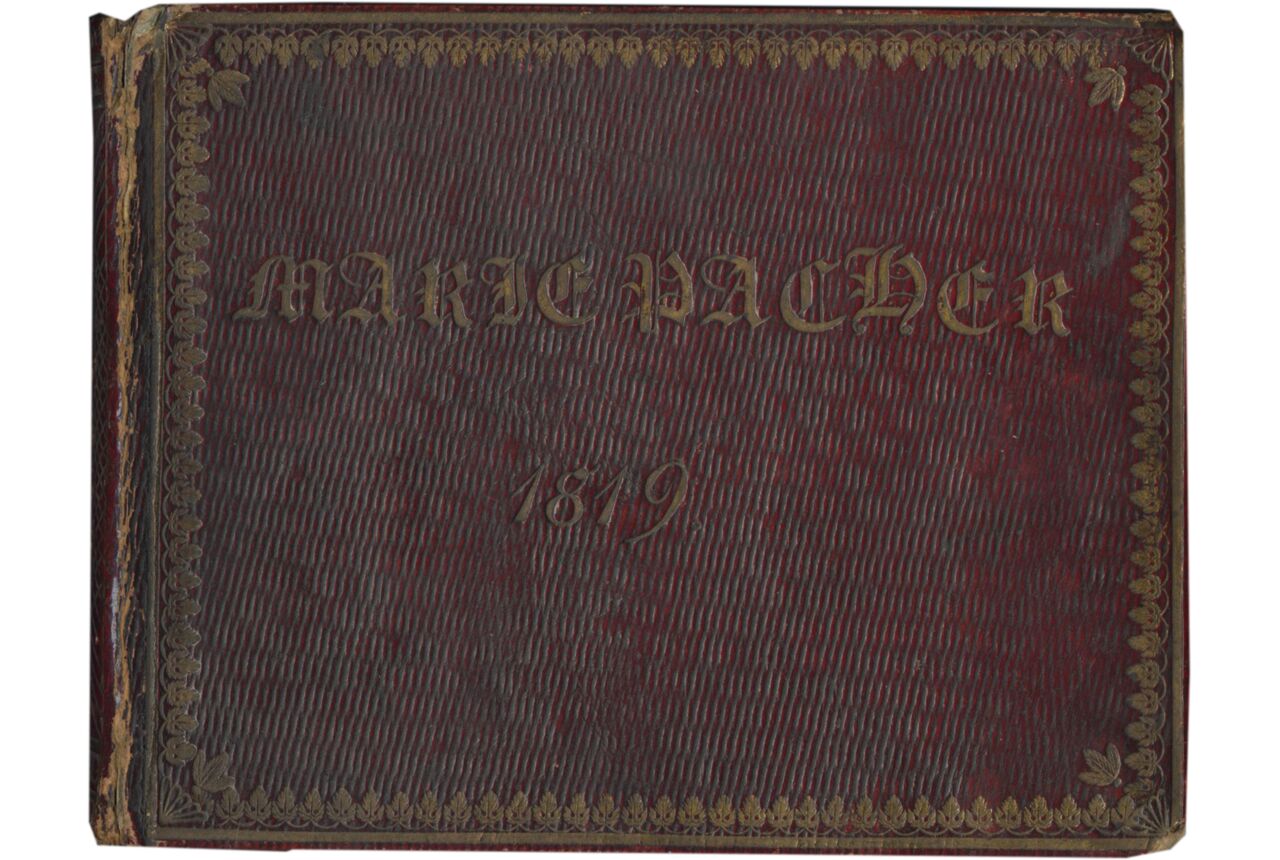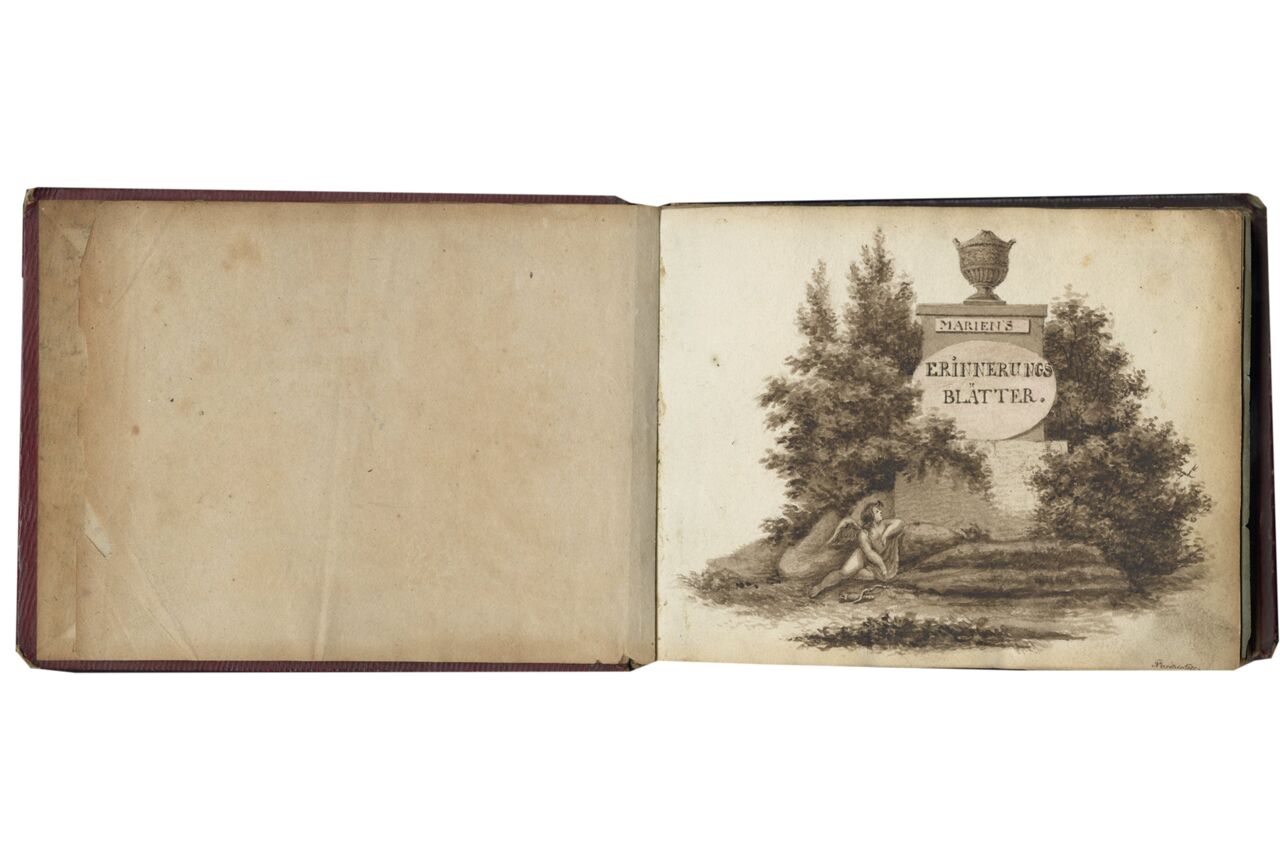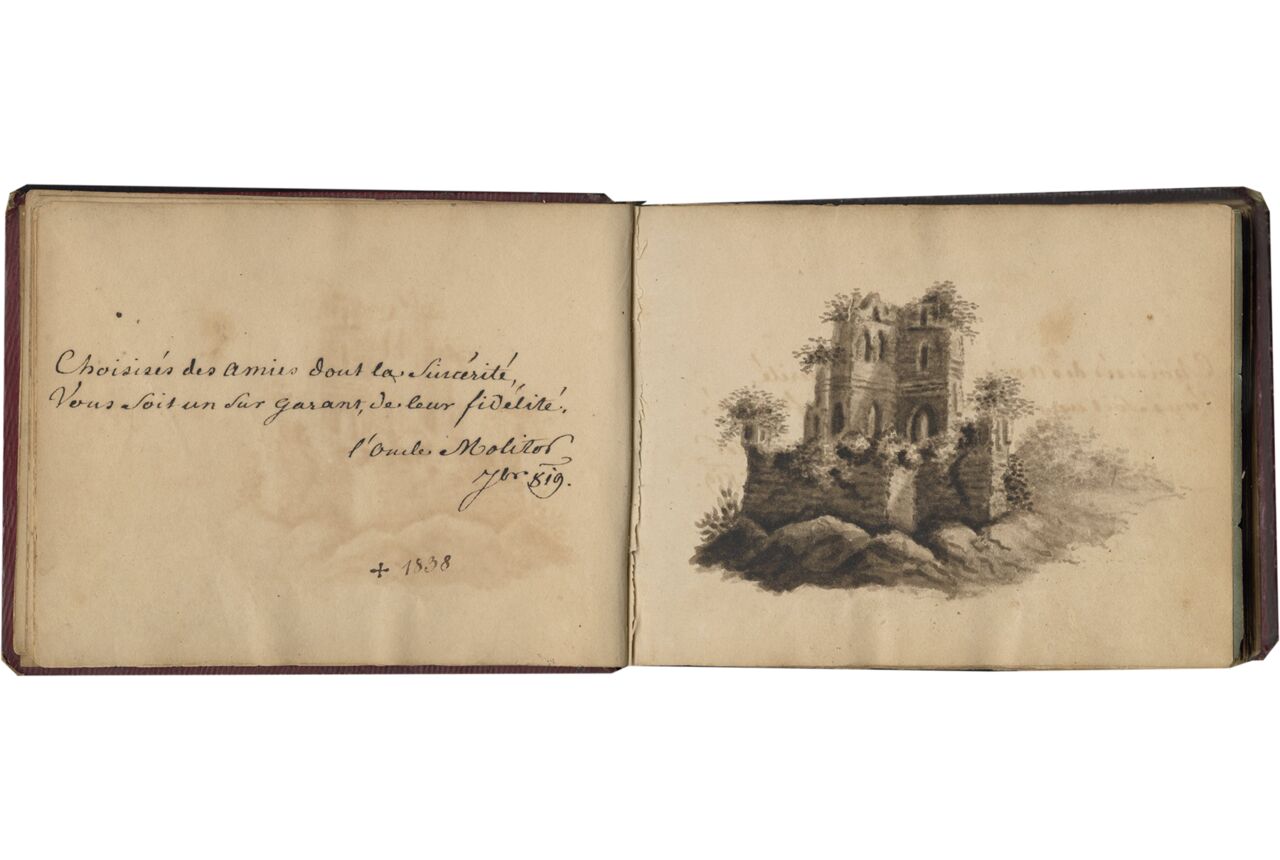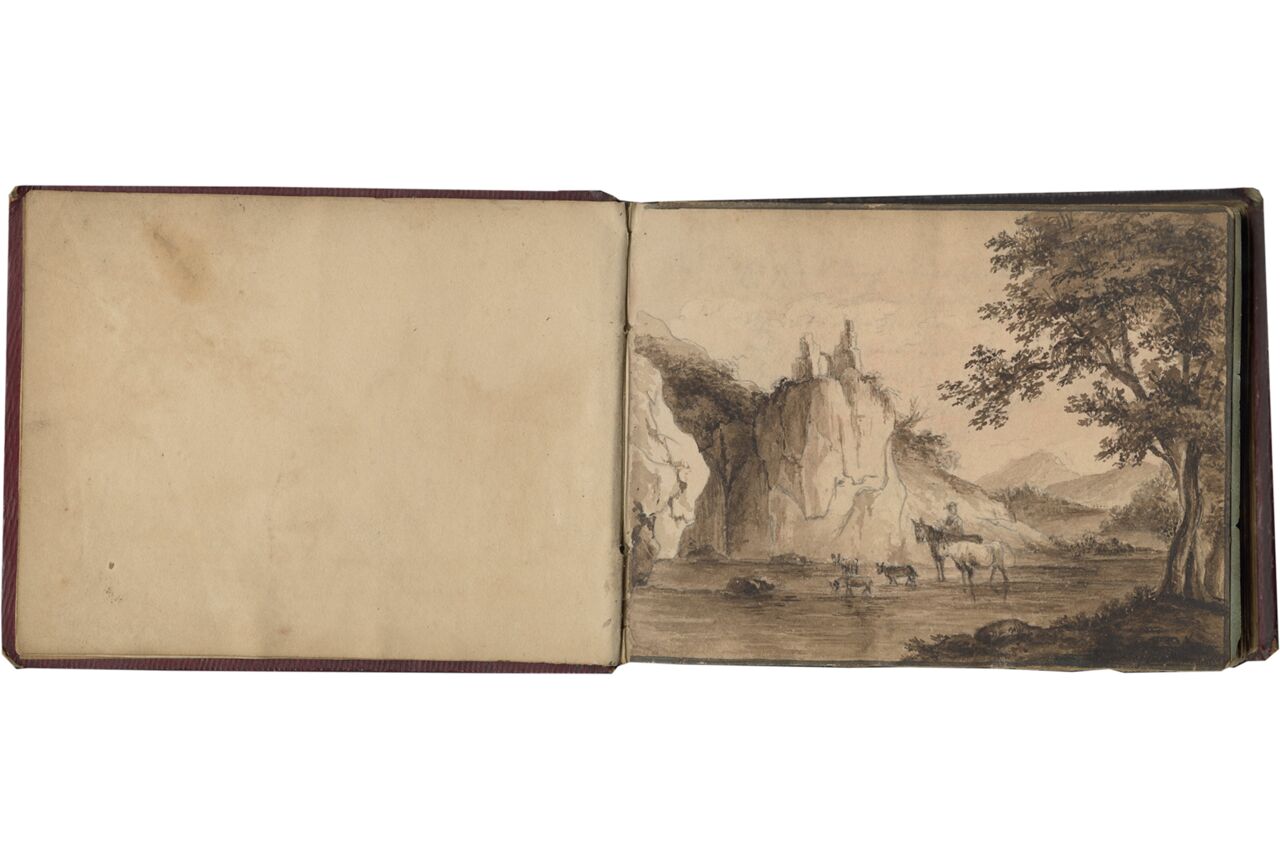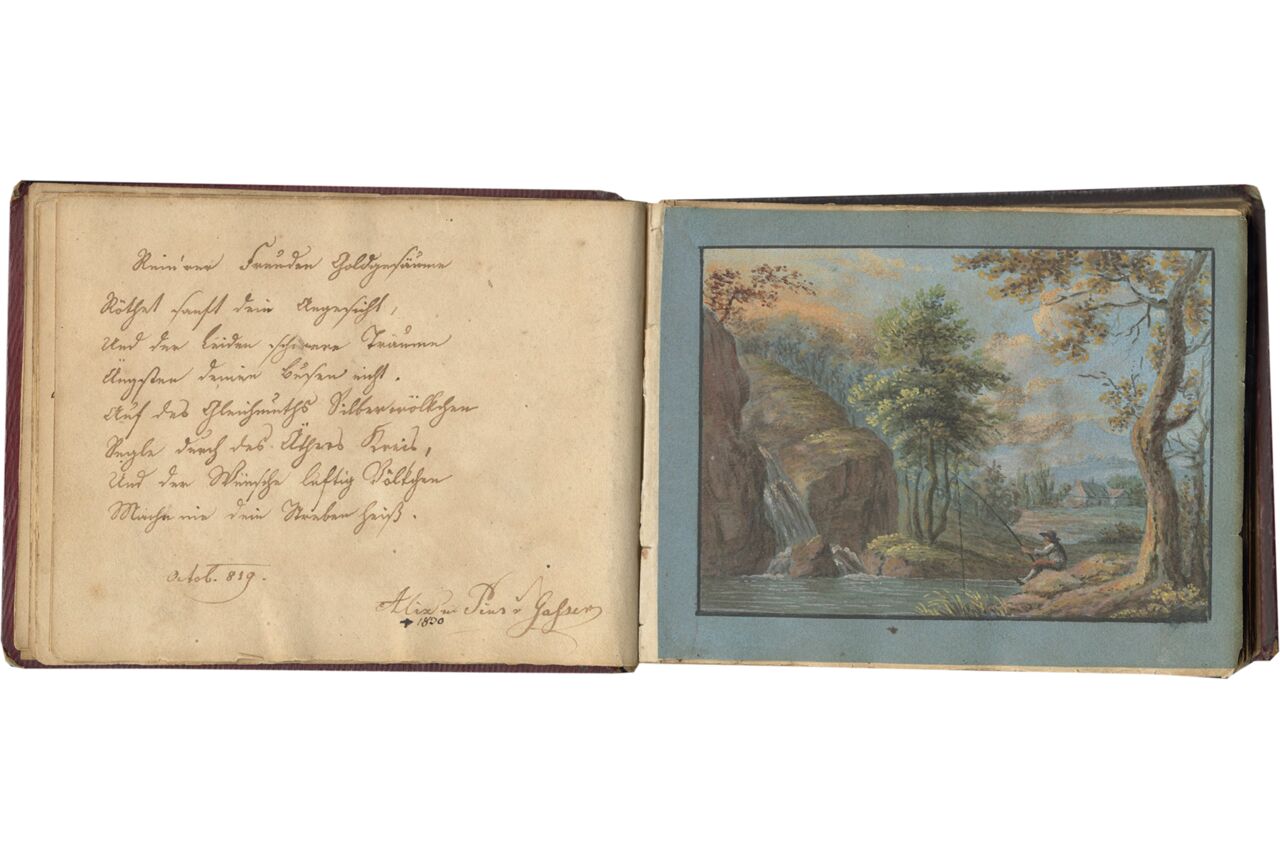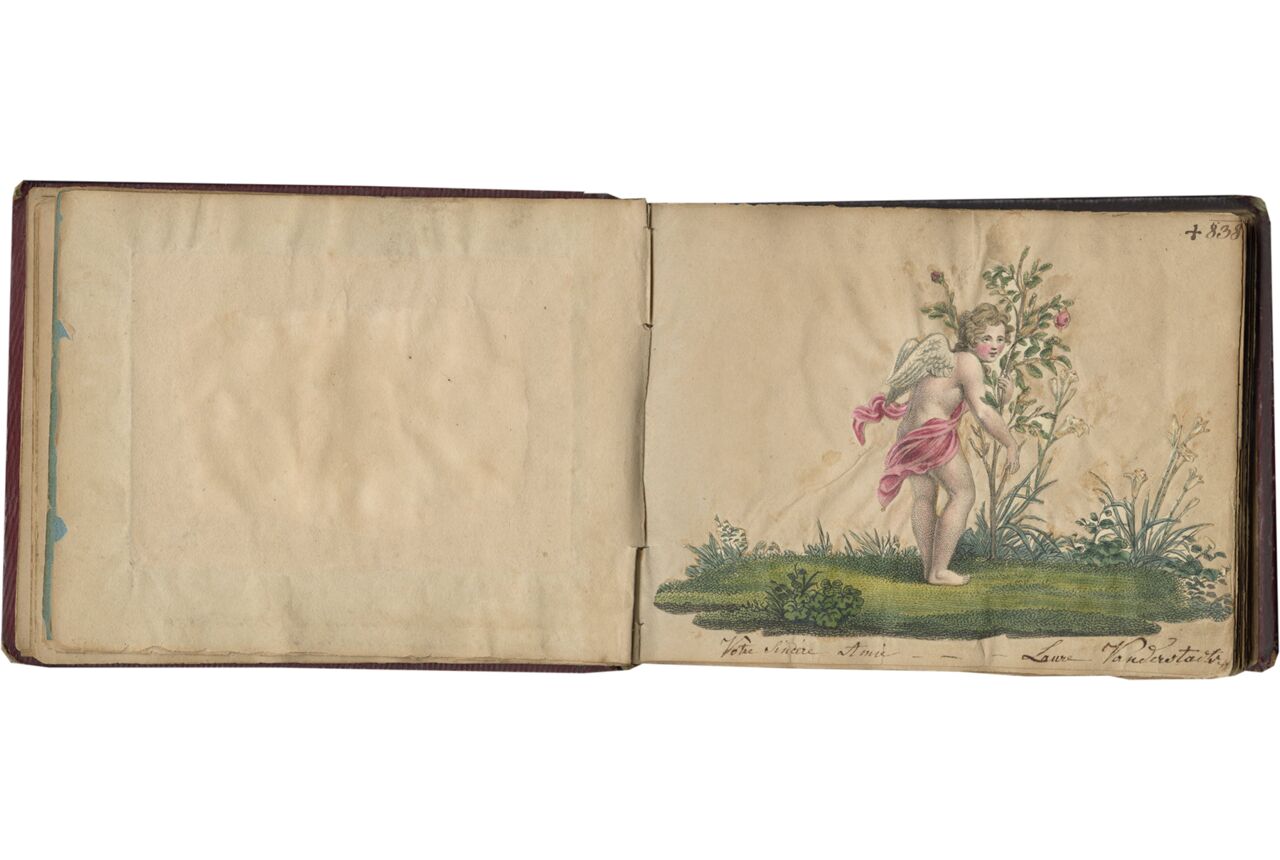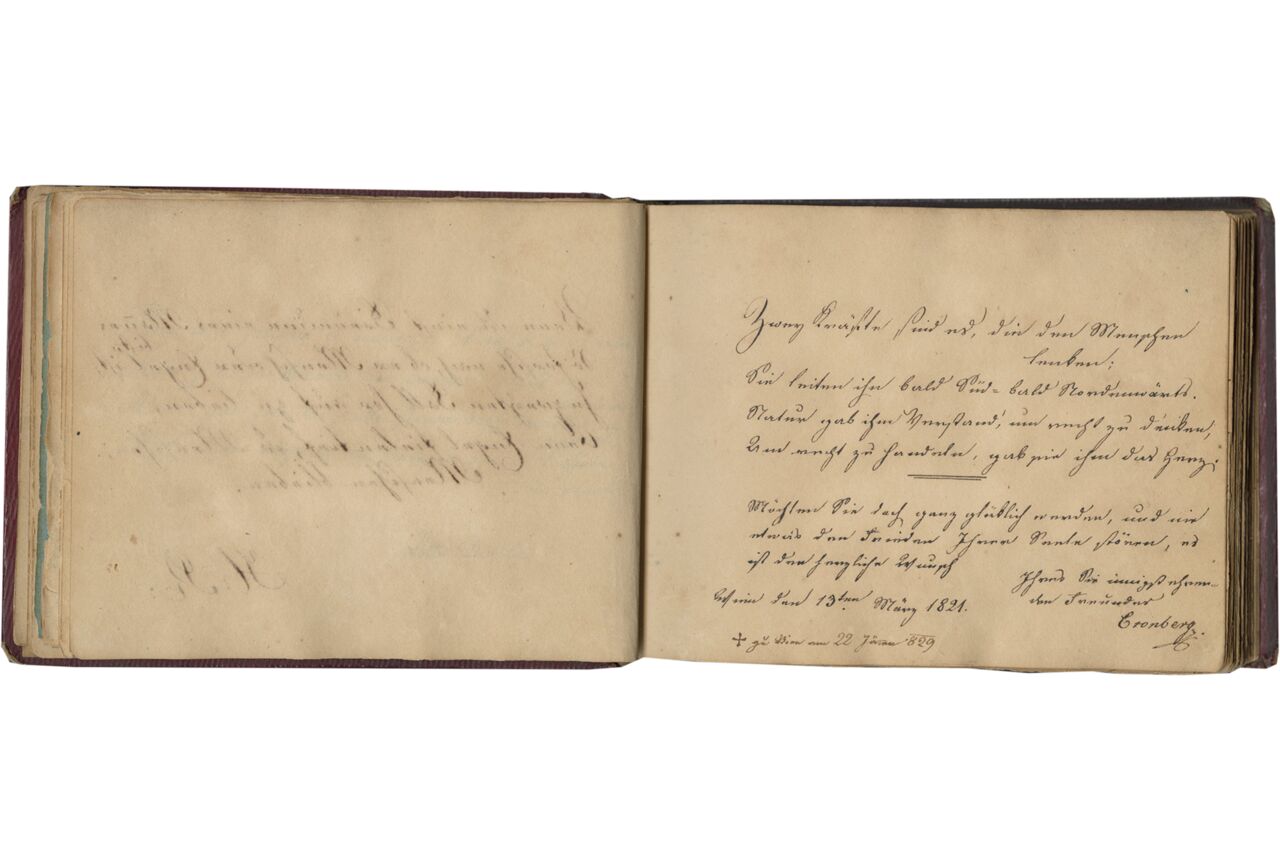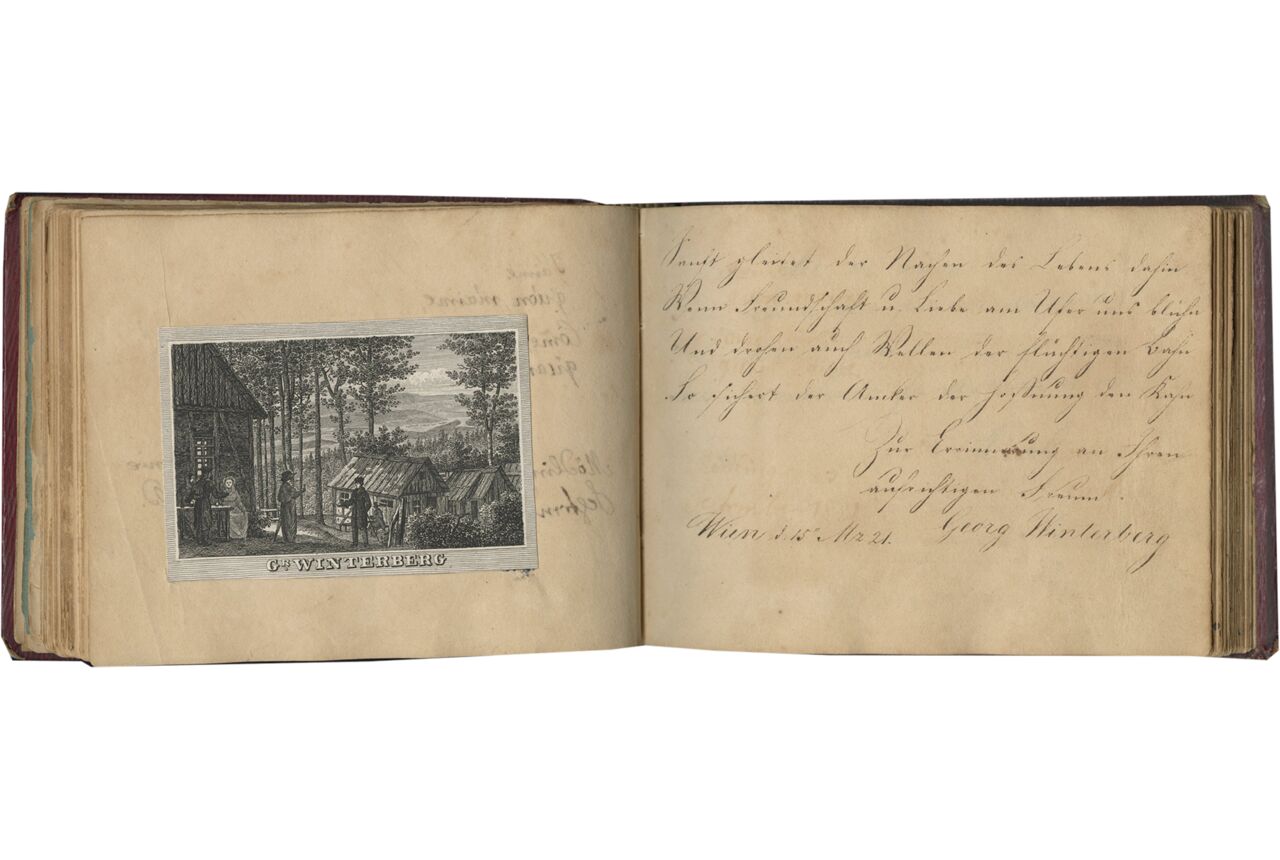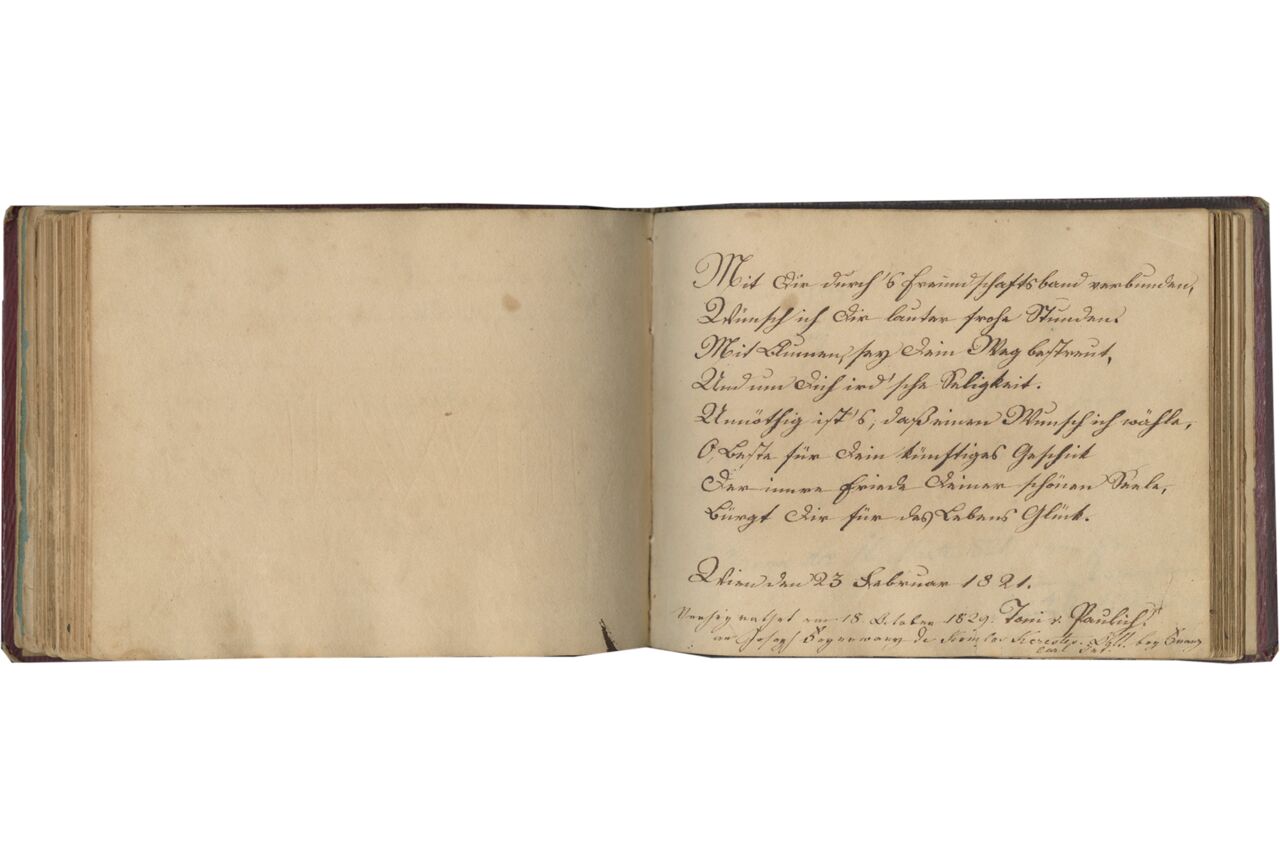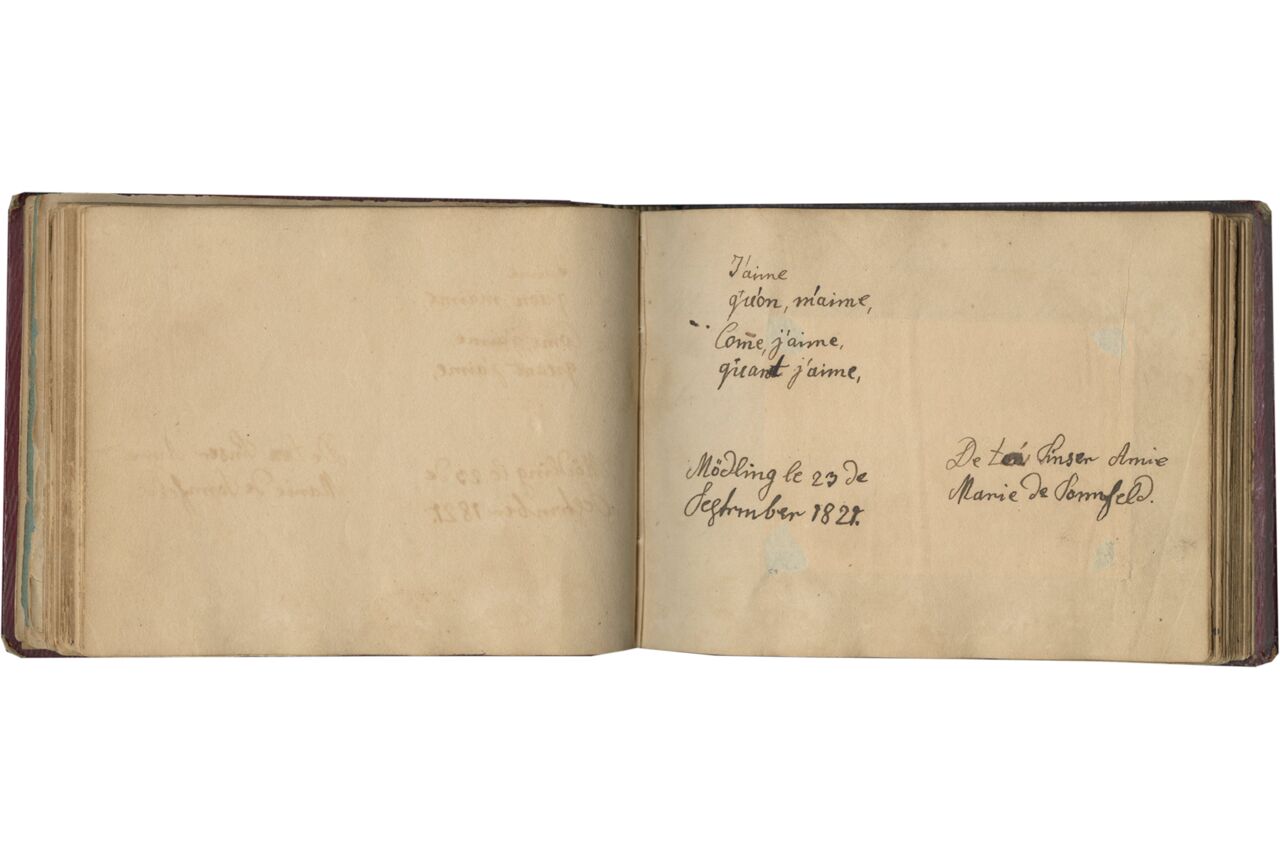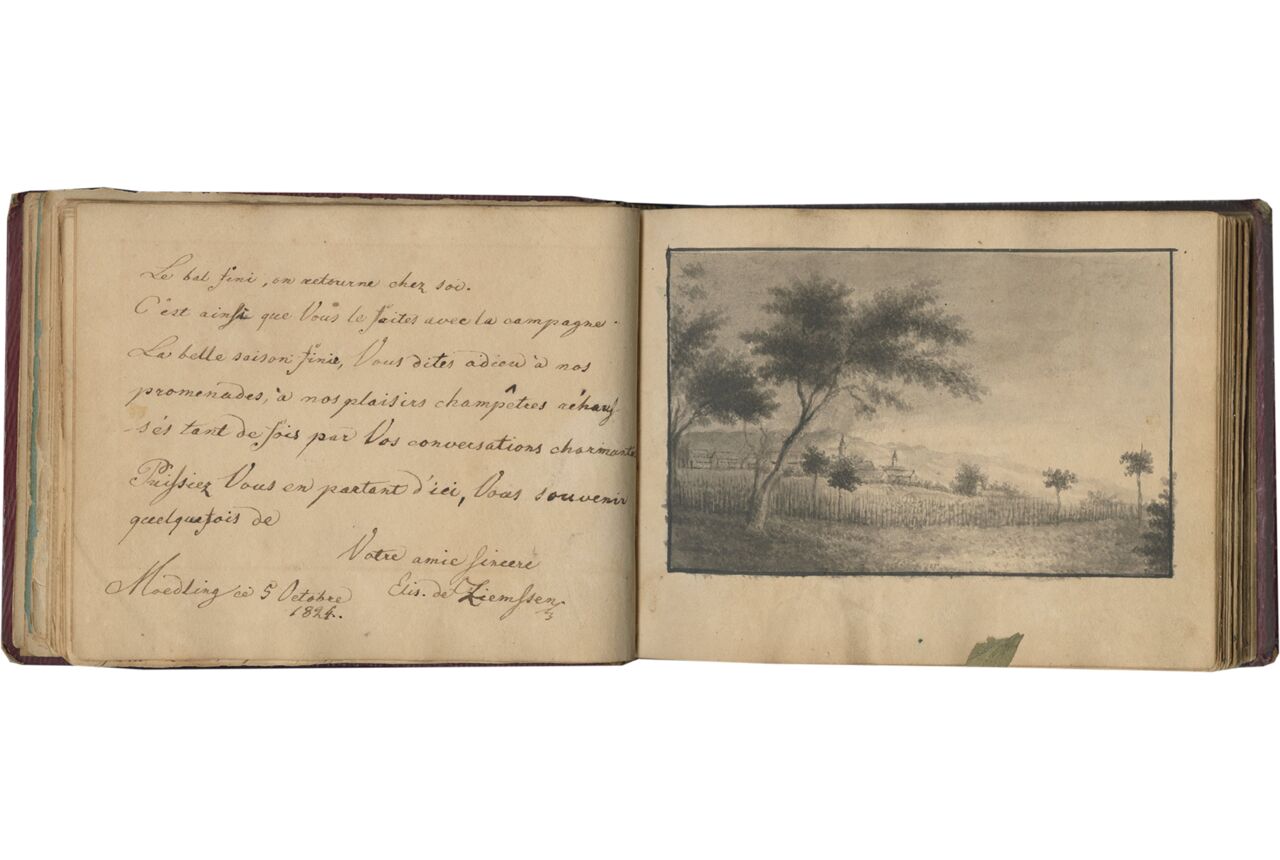i, 124 folios on paper, Whatman paper identified by the watermark “JWHATMAN,” modern foliation in pencil, 1-124, SEVEN WATERCOLORS, ONE PEN-AND-INK DRAWING, FIVE LITHOGRAPHS (four hand-colored), a few dried four-leaf clovers inserted between the leaves, some leaves almost detached from the binding, minor stains, in overall very good condition. In its ORIGINAL BINDING of 1819, red morocco over pasteboards, both covers gold-tooled with a narrow foliage frame and small foliage corner pieces, gilded title on front cover “MARIE PACHER 1819.,”flat spine gold-tooled with interlacing fillets and, at the top and bottom, narrow bands enclosing small lozenges, gilt edges, some wear of leather on the hinges and corners, otherwise in good condition. Dimensions 96 x 125 mm.
Album amicorum (the friendship or autograph album) made for women are not common. This interesting example includes entries mostly by women for a woman, Marie Pacher, an aristocrat residing in two cultural capitals in central Europe, Vienna, and Pressbourg (Bratislava), at the beginning of the nineteenth century. It comprises poems in German and French and beautiful artwork of romantic landscapes, fashion, and allegorical images. The volume provides a fascinating, fresh perspective for writing social history, bringing forth the voices of women, who have often been overlooked in the past.
Provenance
1. The entries in this friendship album were made in 1819-1839 by the friends and family of Marie Pacher in Vienna (Austria), Mödling (outskirts of Vienna) and Pressbourg (Preßburg, Hungary; today the capital of Slovakia, known by its Slovak name, Bratislava). Published in the “Repertorium Alborum Amicorum” (Online Resources).
2. In 2017, appeared at an auction in Königstein: Reiss & Sohn (Königstein/Ts.), Auktion 183: Wertvolle Bücher, Handschriften. Vom Mittelalter bis zur Moderne, 16.-17.5.2017.
Text and Illustration
f. 1, Sepia painting in watercolor representing a landscape with a stele surmounted by an antique vase; a seated putto gazes at words inscribed on the stone: “Marien’s Erinnerungs Blätter.”; his bow and arrows rest on the ground; signed in micrography “Parmentier”;
f. 5, Sepia painting in watercolor representing a man on a horse herding cattle in a rocky landscape;
f. 6, Poem in German, dated Vienna, 10 May 1826;
f. 8v, Short poem, “Choisisés des amies dont la Sincerité, / Vous soit un sur garant de leur fidelité. / l’Oncle Molitor / J(anvi)er(1)819.”;
f. 9, Sepia painting in watercolor representing ruins of a castle in a landscape;
f. 10v, Poem in German, dated October 1819;
f. 11, Watercolor representing a summer landscape with a man fishing at a lake near a waterfall; a farmhouse is seen in the distance beyond the fields;
f. 12, Poem, pasted onto the page, “La Rose est l’image/ de notre Vie,/ La Pensee te rappelle / ton Amie.,” within a garland frame of roses and pansies painted in watercolors, signed Louise Paloesay;
f. 13, Hand-colored lithograph representing a putto clutching a rose bush, on a patch of grass on which grow also white lilies, cut out and pasted onto the page, and signed Laure Vanderstadts;
f. 15v, Poem “Flore m’a permis ce matin...”, signed Lotte Divalot;
f. 16, Poem in German, signed H. R.;
f. 17, Poem in German, dated Vienna, 13 March 1821, signed Cronberg; added below, the date of death, 22 January 1829;
f. 19, Poem in German, dated Vienna, 30 July 1820, signed Laure Vanderstadts;
ff. 21, 22, Poems in German, signed E. Si., and the date of death, 1831, added below on f. 21;
f. 23, Poem “Mon coeur jusqu’au dernier moment...”, signed Anne de Bersuder, date added later, “de Presbourg janvier 1829” ;
f. 24, Poem in German, signed Elisa von Goguel, dated Vienna, 20 December 1823;
f. 25, Poem in German, signed Eugénie de Goguel, dated Vienna, 20 December 1823;
f. 26v, Poem “Le bal fini, on retourne chez soi,/ C’est ainsi que Vous le faites avec la campange,/ La belle saison finie, Vous dites adieu a nos promenades…,” signed Elis. de Ziemssen, and dated Mödling (Austria) 5 October 1824;
f. 27, Sepia painting in watercolor representing a country landscape consisting of a fenced field with scattered trees, and a village and hills in the distance;
f. 28, Poem in German, signed Betti Fachly, Presbourg, January 1829;
f. 29v, Short inscription beginning “Liebe Mimi...”, signed Lotte, Wien im 4. März 1834;
f. 31, Poem “Une tendre amie vaut mieux qu’une Couronne,/ Un monarque n’a rien s’il ne possede un Coeur ...,” signed Fanny Dietcher, 30 Janvier 1824;
f. 32, Three hand-colored lithographs cut out and pasted onto the page of ladies presenting costumes, with descriptions inscribed below “Italienne,” “Napolitaine,” “Bearnaise”;
f. 34, Poem “Tu possede l’aiman vanqueur/ Qui retient ce qu’il attire/ Ta voix est le son du Coeur/ Que d’un seul mot sait tout dire,” signed Clementine Leeb;
f. 39, Short note: “Mariée en 1839 au Major Agathon de Colins-Tarsienne”;
f. 39v, Poem in German, signed Louise von Haudeweld, Vienna, 2 April 1821;
f. 41, Poem in German, signed Nina von Haudeweld, Vienna 10 April 1821;
f. 42, Poem in German, signed Fanny von Sonnfeld, Mödling (Austria) 8 October 1821;
f. 45, Sepia painting in watercolor representing two seated ladies in silk dresses; one of them wears an elaborate headdress; signed Cousin Misha 1831;
f. 45v, Short mention of the date of death, “+ zum H. Mihlov inn 5. Juni 1836”;
f. 48, Poem “J’aime / qu’on m’aime/ Comme j’aime/ quant j’aime,” signed Marie de Sonnfeld, Mödling (Austria), 23 September 1821;
f. 48v, Lithograph representing a landscape with well-dressed people discussing and drinking at tables outside a row of small wooden houses (public houses?), pasted onto the page, entitled “Gr. Winterberg” referring to the mountain Großer Winterberg, on the border with Germany and Czech Republic;
f. 49, Poem in German, signed Georg Winterberg, Vienna, 15 March 1821;
f. 50, poem in Italian, “Felice chi vi mira...”, signed “A. S.”, Presbourg, January 1829;
f. 52r-v, Poem in French, signed Caroline Langerhang, Vienna, 12 Nov 1834;
f. 63, Poem in German, signed Wilhelmina von Garges, 1829; added note of her death in 1829;
f. 75, Poem in German, signed Josephine Maye, Presbourg, January 1829;
f. 78, Poem in German, signed Caroline Pallin, Vienna, 1818/1821;
f. 79, Poem in French, signed, “Votre amie Maria W.”; dated Vienna, 8 August 1821;
f. 80, Poem in German, signed Elise von Goguel (?),
f. 82, Poem in German, signed Toni von Paulies (?), dated Vienna, 23 February 1821, with a later note of 18 October 1829;
f. 83, Poem in German, dated Vienna, 16 March 1821, signed “Carlo Ba…”;
f. 86, Poem in German, dated Mödling (Austria) 21 October1822, signed “Jennifer ….”;
f. 101, Four-leaf clover;
f. 108, Poem in German, dated 26 September (?) 1821, signed Jenny Sax; below the date of death, 2 May 1824;
f. 108v, Poem in German, signed E Ca.l R… (these are the initials on the drawing on the facing folio) dated, Vienna, June 1826;
f. 109, Pen and ink drawing, with gray washes in watercolor, representing two harnessed horses appearing through clouds and standing on their back legs, signed “E. C. R.”; the style with dots and crosshatching suggests that it is copied from a print.
The album amicorum, or album of friends, is a booklet in which young aristocrats collected entries made by their friends, relatives, and acquaintances whom they met during travels and studies. On the pages of the Stammbuch, as it was called in German, friends would usually offer poems, wishes, drawings and watercolors, signed with a date and current location. The album amicorum was popular from the sixteenth until the nineteenth century, mainly among male aristocrats, and in bourgeois and university circles. Most album amicorum were made for men. The example described here, in contrast, was made by women for a woman, adding greatly to its interest.
The pages of this album reflect the life of Marie Pacher over a period of nineteen years from 1819-1838 in Vienna (Austria), Mödling (outskirts of Vienna), and Pressbourg (Preßburg, Hungary; today the capital of Slovakia, known by its Slovak name, Bratislava); both the time and place make its contents particularly interesting for cultural and social history. Pressbourg flourished in the eighteenth century during the reign of Queen Maria Theresa, becoming the most important town in Hungary and the center of social and cultural life in the region. New palaces, monasteries, and mansions were built in the city; Mozart, Haydn and Beethoven gave concerts in different palaces of the city at the end of the eighteenth century. The Peace of Pressbourg between Austria and France was signed in the city in 1805. In 1825 the Hungarian National Learned Society was founded in Pressbourg. As the entries in our manuscript reveal, Marie Pacher spent an equal amount of time in Vienna. This resident city of the Habsburg dynasty since the fifteenth century became in 1804 the capital of the newly formed Austrian Empire. In the late eighteenth century and at the time of our manuscript, Vienna was the center of classical music. Many of the entries indicate that she also resided in Mödling, an area in the Vienna Woods, south of the capital, where several famous castles of wealthy Viennese families were located. At the time of our manuscript, in the beginning of the nineteenth century, Beethoven often visited his favorite pub in Mödling.
The album amicorum is central in modern transdisciplinary research studying texts, reception, and collecting in cultural and social contexts and the history of mentalities; see especially the comprehensive study by Werner Wilhelm Schnabel published in 2003. The albums were made from the sixteenth until the nineteenth century, and throughout their history, they usually assumed an elongated horizontal format, as is also the case for our manuscript. Our album is made on Whatman paper, a wove paper named after its British inventor, James Whatman (1702-1759), whose son, James Whatman the younger (1741-1798), developed the sale of this strong and solid paper in Europe.
Literature
Fechner, J.-U., ed. Stammbücher als kulturhistorische Quellen, Wolfenbütteler Forschungen 11, Munich, 1981.
Keil, R. and R. Die deutschen Stammbücher des sechzehnten bis neunzehnten Jahrhunderts. Ernst und Scherz, Weisheit und Schwank in Original-Mittheilungen zur deutschen Kultur-Geschichte, Berlin, 1893 (reprint Hildesheim, 1975).
Klose, W. “Stammbücher: eine kulturhistorische Betrachtung,” Bibliothek und Wissenschaft 16 (1982), pp. 41-67.
Kurras, L. Zu gutem Gedenken. Kulturhistorische Miniaturen aus Stammbüchern des Germanischen Nationalmuseums 1570-1770, Munich, 1987.
Lilienthal, M. Schediasma critico-literarium de philiothecis varioque earundum usu et abusu, vulgo von Stamm-Büchern, Königsberg, 1712; rev. Wittenberg, 1740 (repr. in Fechner, 1981, pp. 237-298). [the first study of Alba Amicorum].
Nickson, M.A.E. Early Autograph Albums in the British Museum, London, Trustees of the British Museum, 1970.
Rosenheim, M. The album amicorum, Oxford, 1910.
Schnabel, W. W. Das Stammbuch: Konstitution und Geschichte einer textsortenbezogenen Sammelform bis ins erste Drittel des 18. Jahrhunderts, Berlin, 2003.
Schünemann, H. “Stammbücher,” Schrifttumsberichte zur Genealogie und zu ihren Nachbargebieten 2 (1965), pp. 67-108.
Taegert, W. Edler Schatzholden Erinnerns: Bilder in Stammbüchern der Staatsbibliothek Bamberg aus vier Jahrhunderten, Bamberg, 1995.
Thomassen, K., ed. Alba amicorum. Vijf eeuwen vriendscap op papier gezet. Het album amicorum en het poëziealbum in de Nederlanden, Maarssen/The Hague, 1990.
Online Resources
Repertorium Alborum Amicorum
https://raa.gf-franken.de/de/startseite.html
Our manuscript,
https://raa.gf-franken.de/de/suche-nach-stammbuechern.html?permaLink=1819_pacher
Suzanne Karr Schmidt, “Eighteenth-Century Social Networking,” October 20, 2021
https://www.newberry.org/18th-century-social-networking
TM 1275


